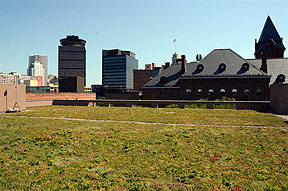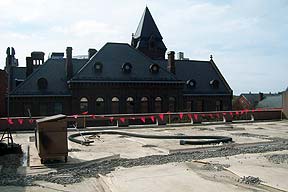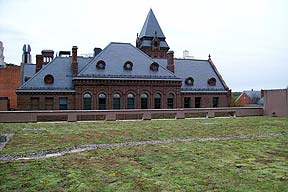 About green roof systems
About green roof systems
Green roofs have a long history, starting with sod roofs in Northern Scandinavia and other places around the world. Modern green roofs having been gaining popularity world-wide since 1960.
Modern green roofs consist of manufactured layers of waterproofing, drainage, soil or growing media, and then vegetation. A green roof may be intensive, extensive, or anywhere in between (semi-intensive). Labor-intensive roofs can include trees, flowers, herb and vegetable plants, and may be designed to be used by people as parks. They require maintenance such as watering, weeding and feeding. Extensive green roofs require minimal maintenance since they contain plants selected for their self-sustaining capabilities, such as perennials resistant to drought, and grasses. People do not typically visit these roofs except for maintenance.
Benefits of extensive green roofs include
• Improved air quality
• Reduced storm water run-off
• Filtration of run-off
• Reduced energy consumption for heating and cooling
About the City Hall green roof project
 The roof garden system is an extensive green roof. Consists of specially manufactured growing medium and sedum plants installed over the existing rooftop waterproofing system, which was completed in 2010. The installation reused materials on the existing roof. The filter fabric remains in place as part of the drainage layer. The gravel ballast, the layer of gravel used to keep the roof material down in the wind, now supports the perimeter of the growing media.
The roof garden system is an extensive green roof. Consists of specially manufactured growing medium and sedum plants installed over the existing rooftop waterproofing system, which was completed in 2010. The installation reused materials on the existing roof. The filter fabric remains in place as part of the drainage layer. The gravel ballast, the layer of gravel used to keep the roof material down in the wind, now supports the perimeter of the growing media.
The City Hall green roof will reduce our energy costs, provide air quality improvements and mitigate the urban heat island effect. Benchmarking is in place to measure energy savings.
A green roof can typically reduce storm water run-off by 50 to 90%, minimizing the impact on the combined sewer system and reducing system overflows during “peak flow” rainfall into the watershed. The City Hall green roof was funded through a grant from the NYS Department of Environmental Conservation Water Quality Improvement Program.
What does it look like up there?
Looking toward the City Hall "A" building, during installation, and after substantial completion:


Looking east - this gives an idea of the preplanted sedum mats. The contractor was able to simply place the mats over the growing medium. These succulent plants were chosen because they are perennial, hardy enough for our winters and they require little to no watering once they are established.

Media Coverage
Interview and photos on InnovationTrail
Questions?
Please contact Anne Spaulding in the Division of Environmental Quality at (585) 428-7474, or email her.